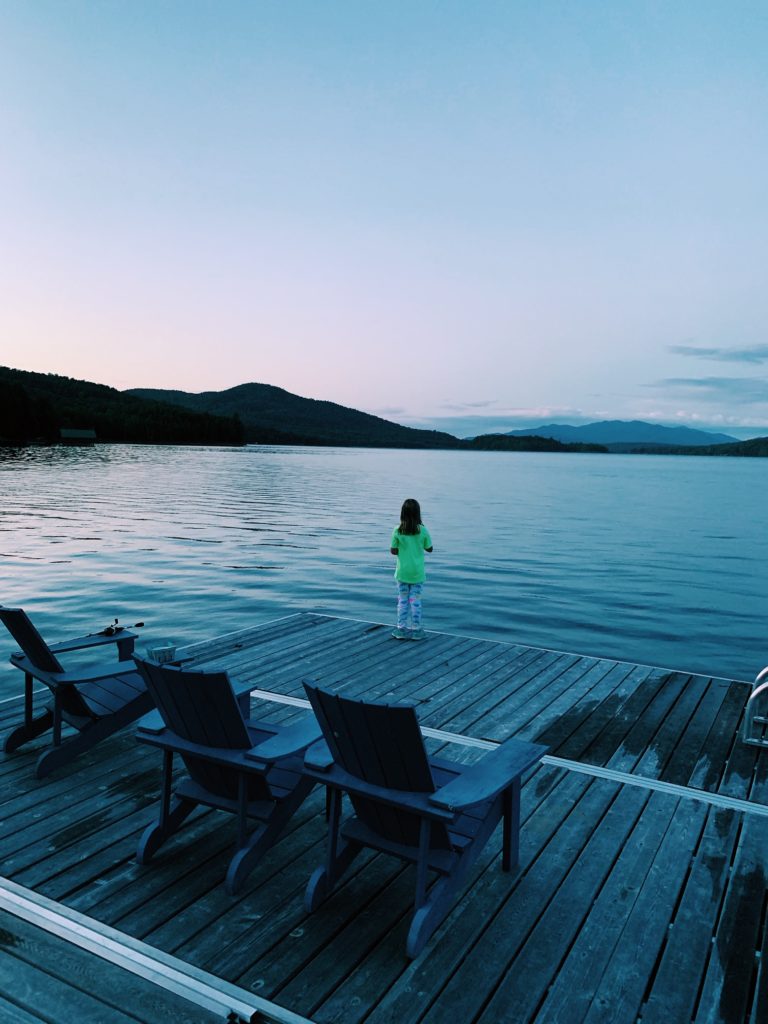To know long, slow days lakeside, is to know deep peace. Even the boisterous laughter and splashing of friends is absorbed out into the quiet of the great expanse and barely ripples the serene surface. I have been fortunate to spend time at many different northern lakes in the US and in Europe and to have consulted for several clients building lake houses. In fact, I am writing this from the shade of a pontoon boat while my kids jump off the dock in the bright sparkle of late morning. As a landscape architect who has seen how construction predictably alters a site and an opinionated lake lover, I wanted to share my thoughts on the landscape of lake houses.
THE critical first step is defining the area of disturbance. This choice needs to be made intentionally early on or it will be made by others for you and it has far-reaching consequences. Disturbance is when vegetation is removed or the ground driven on, or even walked on, enough to trample existing vegetation. Unless the property is overrun by invasive plants, or similarly negatively affected, my opinion here is universal: minimize the area of disturbance. Your first instinct may be to open the space up for sunlight and views of the lake, but the trade-off will be: vastly decreased privacy, construction machinery compacting the soil during construction, machinery needed to de-compact the soil post construction, required planting or mulching of every square foot of disturbed soil, likely irrigation of every square foot of disturbed soil, increased rainwater runoff and erosion due to the decreased porosity of the soil, higher increased maintenance cost, more people on your property to maintain it, likely a more suburban feel to the property. I could go on. At least allow yourself time on site to consider the pros and cons and to give yourself the opportunity to feel comfortable in a more vegetated environment – you may come to love it. And once you do define the area of disturbance, fence it off with a wood or metal fence, anything lighter will be removed by a contractor at some point.
Spend lots of time on site before drawing up plans. Notice all phenomena such as light, air movement, sound, views, exactly which branches or trees obscure the views, the reflection of the water on trees and other surfaces. Harnessing these phenomena makes the experience of the landscape interesting and engaging. Give yourself time to observe the existing property so you don’t inadvertently destroy some great aspect of it. Many a lake house has suffered from pinterest inspiration boards. Take your cues from your unique property and your unique lifestyle to create something supremely you. Which brings me to the next point.
Before starting the design, make a list of all the activities you will do, who you will do them with and when you will do them. Do you like to start the morning with a swim or a book and coffee? Does your group tend to split up or stay together? Do you love a rustic wood fire in nature or a sleek gas fire table on the terrace? Will you play lawn games? Cook? Need beverages handy at all times? A quiet place to escape from guests? One way to start thinking about ideas to imagine a specific weekend. Think about every minute of the perfect day, what you will be doing, who is there, and what natural phenomena will be happening. From the arrival experience (Is it grand? Secret? Natural? Estately? Wild? Cozy?) to bedtime (will others still be awake to disturb your sleep?) and you will start to paint a picture that you can communicate to your consultants.
After the above considerations are made, it is time to consider aesthetics and design. Keep in mind there are a million ways to make a beautiful landscape, but very few that are the authentic manifestation of your unique property and your unique personality and lifestyle.
A few general recommendations:
Existing trees provide privacy from boat traffic, keep the soil porous so that it absorbs rainwater (preventing erosion), provide shade that keeps weeds at bay, and drop their leaves to provide mulch. When the sun is lower in the sky, the light still enters the house and low branches can be pruned to create interesting framed views of the lake. For these reasons, less tree cutting is often a good choice.
Keep it simple and low maintenance unless you have a trusted team for the inevitable maintenance. The fewer people on your property the better.
Find a local person you trust to oversee your property and any work that goes on there.
Use high performance materials and plantings. Native plantings can have the added benefit of being a habitat for desirable wildlife.
When possible, separate the functional (and unpleasant) from the living areas. Go ahead and put a separate driveway and outbuilding to house and screen things like equipment, trash enclosures, & storage. Make it easy access for service people so they won’t need to enter the heart of the property and disrupt the peace while you are relaxing.
Utilize lots of creative storage so things are easily at hand.
Make a place to get out onto the water. Especially when existing trees are left in place, getting out into the sun and having unobstructed views of the lake is paramount. A beach, a long dock with swim pad, even a docked boat with great seating provides a comfortable place to hang out and swim or play. Given the choice, better to invest in lake side infrastructure and save on cutting down trees and mowing grass.

